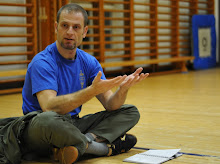
Since during our current training sessions of the Göteborgs Systema-RMA Klubb we're emphasizing on fist fighting, I would like to present this basic analysis of the various constituting elements and the way Systema basic principles apply to combat with hand strikes. I hope all of you will find it interesting and hopefully helpful in your training.
To begin with, there are basically three things we do in Systema after we deform our structure so as to "zero out" the force of a strike coming our way. We either a) spring back to form and release the stored elastic energy in the form of a counter strike, b) confirm the incoming force, break the opponent's structure in order to cause a cognitive gap or c) rotate keeping in close contact with the opponent, once again to affect his structure and balance. Obviously, fist fighting is described in case (a).
Now the elements that comprise Systema fist fighting and the areas that we want to address with our training are the following:
1. Receiving Strikes: The ability of our body to absorb force, dissipate it towards the rest of our structure and store it as elastic energy in our connective tissue (tendons, ligaments, myo-fasciae) through "wave" movement. I believe it is obvious that shockability plays not only a bio-mechanical role but also an important psychological one in the realm of hand-to-hand combat.
2. Movement as Defense: This term is borrowed by Serbian Systema senior instructor Alex Costic (Emmanuel Manolakakis uses the term "evasion skills"). In Western boxing, where we know exactly where our opponent is (in the ring, standing in front of us:-) and his attacks come from specific angles, the defense consists basically of exposing the least amount of our body, through our stance (we face the opponent sideways) and the "guard" position of our arms and hands, that cover the frontal vital targets. In Russian Martial Art the attacks might come from unexpected angles and we're also trying to cover the possibility of multi-person attacks, so our defense is mainly getting out of the way of force, wherever that may come from. This can be done by:
- walking out of the way (as Mikhail Ryabko says, "move with the feet"),
- yielding to the force (deforming our structure)
- deflecting the force with the hands and arms, AFTER yielding, or
- any combination of the above (which happens most often).
3. From Any Position Any Strike: Once again, unlike Western boxing, where the power generation platform and delivery system is so specific (the staggered stance), that we try to keep it intact while moving around, and the strikes can only be straights, hooks or uppercuts, in Systema we want to be able to generate significant force with our fists, palm strikes, hammerfists, backhands etc towards any direction, and not only to the front. The trajectories of the strikes in RMA, instead of one-dimentional (like the straight boxing punches) or two-dimentional (like the hooks and uppercuts) follow a figure-eight pattern, which not only makes them unpredictable but is also a large part of the secret behind the "uncanny" power of Systema punches. Of course it is of utmost importance to always try to punch without breaking our form. The strikes can either be:
- Ballistic, i.e. producing impellent force, to cause pain and injury, just like in Western boxing, or
- Structural, i.e. disrupting the opponent's structure so that he's momentarily unable to launch further attacks.
Based on this analysis I believe it becomes easier to classify the overwhelming number of Systema drills (a friend tried to write down all the drills he had seen in a small number of DVDs and he exhausted himself at 200!) but even more important, to create our own drills, based on the attributes and skills we're trying to cultivate. I sincerely hope this will help to make your training sessions more productive. Let me know what you think!







No comments:
Post a Comment